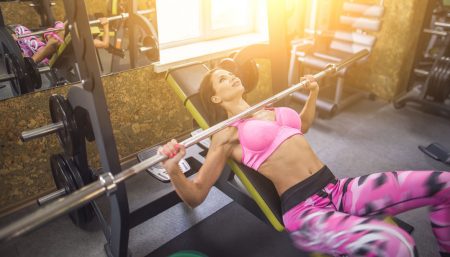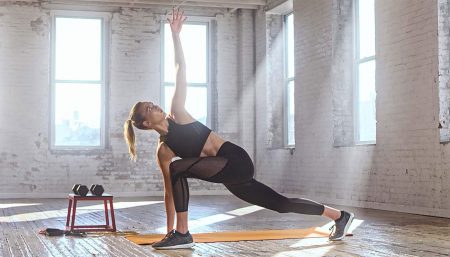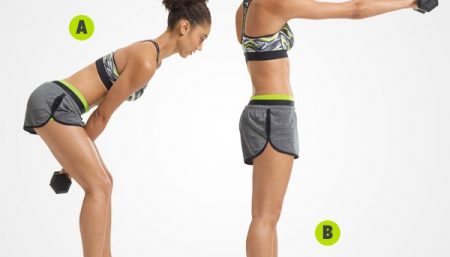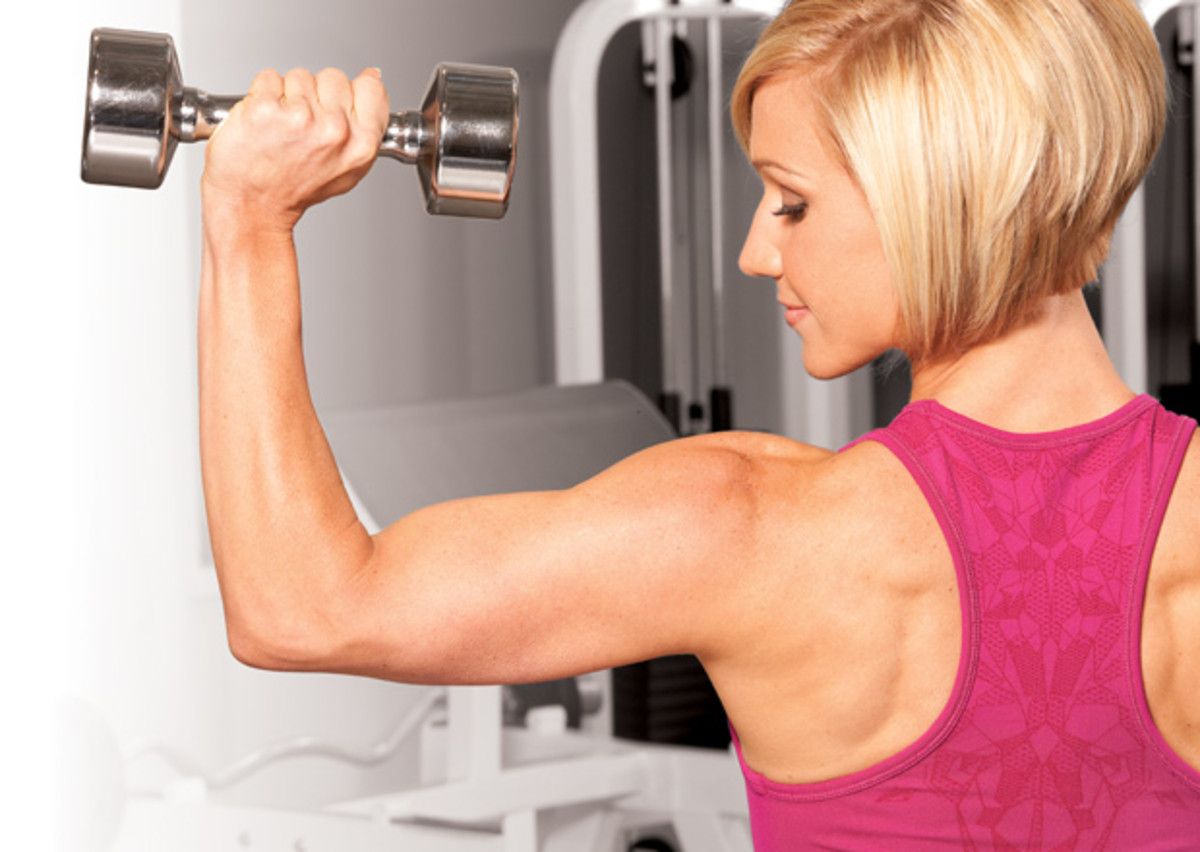
Shoulder pain accounts for 16% of all reported muscle and joint pain, second only to lower-back discomfort. The potential causes are myriad, from fraying cartilage and inflamed bursa to more serious tears in the rotator cuff (a juncture of four tendons at the top of the shoulder) that help it rotate smoothly and keep it stable. Arthritis, pinched nerves, and a general tightening of the joint called frozen shoulder can also make daily activities-even washing your hair or brushing your teeth-difficult.
Strength training shoulder exercises for seniors and the elderly can have a significant and lasting effect on your independence as we age. Upper body and shoulder exercises can not only improve function in older adults, it can actually reverse some of the muscle loss and deterioration associated with aging.
Perform 3 or 4 exercises from the list below. Rotate with a new set of 3 or 4 of the exercises the next week. Work your way through the exercises until you complete all 12. You should begin to feel stronger, more flexible and better able to accomplish tasks at home.
![]() Bicep Curl with Tube: Stand in the basic step position. The front foot fixes the middle of the tube on the floor. The arms are at the sides of your body and bent so far that the tube is a little taut. Move both ends of the tube simultaneously upwards in an even movement. Only the forearm is moved, the upper arm rests on your body. Keep your elbows close to your body. You can also stand with both feet on the tube in the basic position with your feet parallel. Note: While performing, your hands should form a straight line with your forearms. This exercise, strengthens the upper part of your arm with elbow to make lifting activities easier.
Bicep Curl with Tube: Stand in the basic step position. The front foot fixes the middle of the tube on the floor. The arms are at the sides of your body and bent so far that the tube is a little taut. Move both ends of the tube simultaneously upwards in an even movement. Only the forearm is moved, the upper arm rests on your body. Keep your elbows close to your body. You can also stand with both feet on the tube in the basic position with your feet parallel. Note: While performing, your hands should form a straight line with your forearms. This exercise, strengthens the upper part of your arm with elbow to make lifting activities easier.
![]() Overhead Elbow Extension: Standing or sitting grasp a dumbbell of desired weight. Be sure to keep the core tight throughout the entire lift. Raise the weight vertically into the starting position. (If the weight is heavy, getting it into position overhead may be tricky. Grasp the dumbbell handle with both hands side-by-side and forcefully curl the weight upward. Once the weight is about level with the forehead, rotate it so that the hands are facing upward and on the underside of the top bell, thereby supporting the weight overhead.)Lower the weight downward (behind the head) until the forearms reach horizontal, inhaling throughout the movement. Press the weight upwards to the starting position, exhaling throughout the movement. Repeat. Sets should generally fall between 2-3 with 6-12 repetitions. This exercise will help strengthen the upper arm muscles and improves your ability to lift your arms above your shoulders when reaching high to a shelf.
Overhead Elbow Extension: Standing or sitting grasp a dumbbell of desired weight. Be sure to keep the core tight throughout the entire lift. Raise the weight vertically into the starting position. (If the weight is heavy, getting it into position overhead may be tricky. Grasp the dumbbell handle with both hands side-by-side and forcefully curl the weight upward. Once the weight is about level with the forehead, rotate it so that the hands are facing upward and on the underside of the top bell, thereby supporting the weight overhead.)Lower the weight downward (behind the head) until the forearms reach horizontal, inhaling throughout the movement. Press the weight upwards to the starting position, exhaling throughout the movement. Repeat. Sets should generally fall between 2-3 with 6-12 repetitions. This exercise will help strengthen the upper arm muscles and improves your ability to lift your arms above your shoulders when reaching high to a shelf.
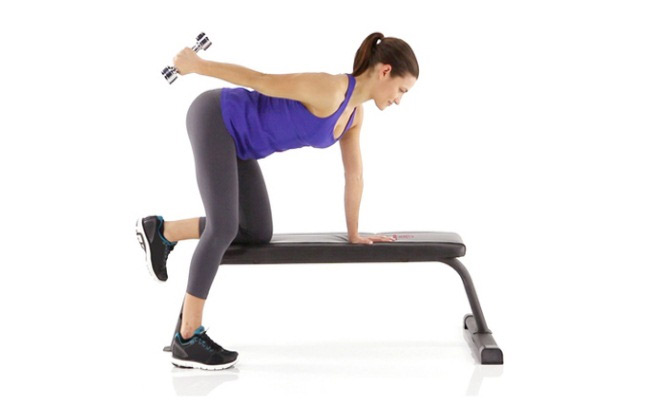
![]() Triceps Kickbacks: Lean over your knee if sitting, or over a chair or table if standing. Hold the weight in your hand. Straighten your elbow behind you as far as comfortable. Return to the start position and repeat 10 times. This exercise aims to strengthen and tone arms and improve your ability to rise from a chair.
Triceps Kickbacks: Lean over your knee if sitting, or over a chair or table if standing. Hold the weight in your hand. Straighten your elbow behind you as far as comfortable. Return to the start position and repeat 10 times. This exercise aims to strengthen and tone arms and improve your ability to rise from a chair.
![]() Diagonal Inward Shoulder Raise: To perform, sit or stand with weight in your hand at your side. Hold palm outward. With palm forward, lift your arm up and across your body to the opposite shoulder. Bend the elbow as you bring the arm up and face the palm inward. Return to the starting position and repeat 10 times. You can build the strength in your upper arm and back with arm training and increase the mobility of your shoulder for better arm swing while walking.
Diagonal Inward Shoulder Raise: To perform, sit or stand with weight in your hand at your side. Hold palm outward. With palm forward, lift your arm up and across your body to the opposite shoulder. Bend the elbow as you bring the arm up and face the palm inward. Return to the starting position and repeat 10 times. You can build the strength in your upper arm and back with arm training and increase the mobility of your shoulder for better arm swing while walking.
![]() Diagonal Outward Shoulder Raise: Sit or stand with weight in your hand crossed over to your opposite hip with the palm inward. Lift your arm up and across your body to the side ending with your palm outward. Return to the starting position and repeat 10 times.
Diagonal Outward Shoulder Raise: Sit or stand with weight in your hand crossed over to your opposite hip with the palm inward. Lift your arm up and across your body to the side ending with your palm outward. Return to the starting position and repeat 10 times.
![]() Shoulder Rolls: Stand or sit with weights in hands, arms at side. Feet are shoulder width apart. Raise shoulders upward toward ears, backward and down. Return to the starting position and repeat 15 – 20 times. This exercise improves the mobility and stabilizes the shoulder blades for heavier lifting.
Shoulder Rolls: Stand or sit with weights in hands, arms at side. Feet are shoulder width apart. Raise shoulders upward toward ears, backward and down. Return to the starting position and repeat 15 – 20 times. This exercise improves the mobility and stabilizes the shoulder blades for heavier lifting.
![]() Overhead Press: To perform, hold the bar (independent of weights) on your front shoulders and stand shoulder width apart. Hands should never touch your shoulders. Gripping the bar close to your wrist, in the base of your palm. Do not close to your fingers. Press the bar overhead in a straight line. Unfortunately your head is in the way. So you’ll need to move your head & torso during the overhead Press. Press until your elbows are locked. Then shrug your traps for extra support. Hold for a second and travel back to your shoulder. Once you have mastered the exercise without weight, begin loading. This will improve the ability to safely reach overhead and increases the mobility of the shoulder joint.
Overhead Press: To perform, hold the bar (independent of weights) on your front shoulders and stand shoulder width apart. Hands should never touch your shoulders. Gripping the bar close to your wrist, in the base of your palm. Do not close to your fingers. Press the bar overhead in a straight line. Unfortunately your head is in the way. So you’ll need to move your head & torso during the overhead Press. Press until your elbows are locked. Then shrug your traps for extra support. Hold for a second and travel back to your shoulder. Once you have mastered the exercise without weight, begin loading. This will improve the ability to safely reach overhead and increases the mobility of the shoulder joint.
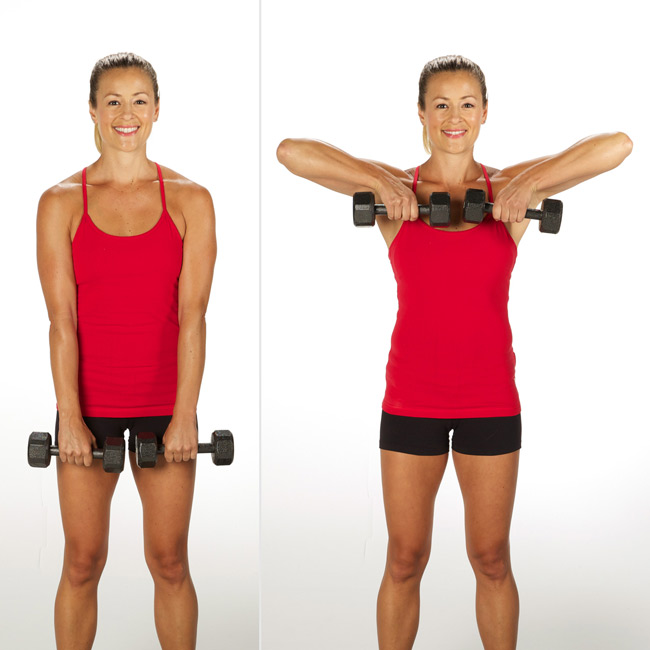
![]() Upright Rows: Stand with weights in hand in front of hips. Feet are shoulder width apart. Lift the weight upward toward your chin, bending your elbows. Return to the starting position and repeat 10 times.
Upright Rows: Stand with weights in hand in front of hips. Feet are shoulder width apart. Lift the weight upward toward your chin, bending your elbows. Return to the starting position and repeat 10 times.
You can increase the strength in your upper arms and back with upper arm exercises. This exercise assists in the mobility of your shoulder and elbow joints.
![]() Side Shoulder Raises: Begin with your arm at your side, elbow straight, holding the weight with palm forward. Raise your arm outward to the side and overhead. Return to the starting position and repeat 10 times. Strengthen your upper arms, shoulders and chest with this shoulder exercise.
Side Shoulder Raises: Begin with your arm at your side, elbow straight, holding the weight with palm forward. Raise your arm outward to the side and overhead. Return to the starting position and repeat 10 times. Strengthen your upper arms, shoulders and chest with this shoulder exercise.
Elbow Side Extensions: Begin with feet shoulder width apart, feet flat on the floor. Holding weights in hands, elbows bent, palms inward on chest. Straighten arms to the sides. Return to the starting position and repeat 10 times. To help strengthen your upper arm and shoulders and improve your ability to grip and pull.
The upper body and shoulder exercises listed above have the advantage of simulating real life situations of lifting. They will promote bone mineralization, help prevent osteoporosis and stabilize your supporting muscles.
Disclaimer
The Content is not intended to be a substitute for professional medical advice, diagnosis, or treatment. Always seek the advice of your physician or other qualified health provider with any questions you may have regarding a medical condition.

